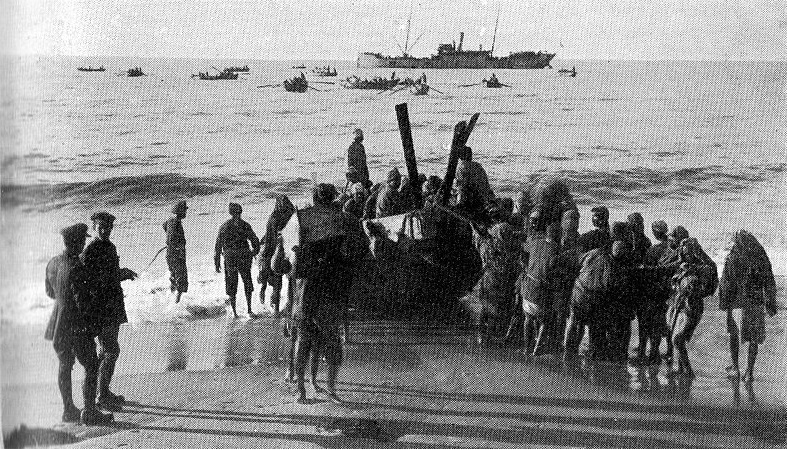All week I have pondered a subject for this post (with the Carole King song running through my head), and, now that the week is nearly over, one has finally come to me. The research is so fresh that it should have been obvious! Last Sunday I visited my local Family History Center and used their portal to access to Newspapers.com. Perhaps it slipped my mind because it was not my intended research topic, but a quick dipping of my toe before I moved on to my main plan.
In my speedy foray into the world of newpapers, I stumbled across several articles about the Brosius boys away in France during WWI. The earliest of these is dated 18 Oct 1917, before Ormond Brosius had left for Europe:
Likes Army Life.
Ormond Brosius, Sergeant in Artillery stationed at Fort Bliss, Texas, writes his parents, Mr. and Mrs. John Brosius, that army life suits him and that his already dark skin is now so thoroughly tanned it is difficult to distinguis him from the Mexicans. Ormond volunteered in the regular army last April in company with Frank Ward and Bert Sherrod and they were in San Francisco until June when Ormond and Frank were transferred to Fort Bliss.
This article enabled me to add a few more details to my knowledge of Ormond's movements during the war. It also lines up to a certain extent with Ormond's own account of his enlistment:
There was three of us. When war was declared there was three of us... Frank Keller and myself and Bert Sheridan. We got on the Missouri-Pacific and went up to Wichita to enlist. Well, they told their right age. I was 16, see, and they was 18. So we got in this line... Ol’ Bert says, “I’m 18.” This old boy wrote it down. “Go on.” And Frank Keller was a-next... When they come to me, I told the truth. I said, “16.” And he said, “Young man, you come back in a couple of years.” So, the next morning I got right in this line, and when I got there I told him, “18.” “Go right ahead.” See? That’s how that happened. See. Boy, it pays to be a liar sometimes.
The first names are identical, even if the last names are not quite the same. Sheridan is quite similar to Sherrod, though. I also enjoyed the reference in the article to Ormond's dark skin. I have come across similar references on his mother's (Wade) line, and it is interesting to see how the trait is passed down the generations.
The next article helps to clarify the confusion between the names "Frank Ward" and "Frank Keller."
Mrs. E. A. Keller this week received a card announcing the safe arrival in France of her son, Frank Ward, who was at a cantonment in Texas. Ormond Brosius was with the same detachment.
It seems that Frank and his mother had different last names, and that Ormond was simply giving them the same surname. The date of arrival in France makes sense, given that the company had departed from Hoboken aboard the Aeolus on 23 Apr 1918. The 16 May 1918 printing of this note allows for the time for the troops to arrive in France, Frank to write the card, and the card to travel back across the ocean and then across land to Kansas.
It seems it took a little bit longer for Ormond to send news to his parents, but when he did it was not just a card but a whole letter.
Ormond Brosius writes his parents Mr. and Mrs. John Brosius of this city from somewhere in France, a cheerful letter telling of his safe arrival, good health and some of the quaint customs of the people of that land, which are a source of wonder and amusement to our soldier boys. He was enthusiastic over the country and well satisfied to be there under his own flag. Ormond enlisted early in the activities.
I can only wish the newspaper had printed the entire letter, as it did with one of his half-brother Harry's, which I transcribed in his Military Monday post and will not repeat here.
Speaking of Harry, the next clipping finally mentions him. Admittedly, I was more interested in finding articles regarding Ormond, in whose cabin I spent a wonderful vacation, than in Harry. When I have more time to dedicate to this newspaper research I will do a more thorough job.
John Brosius and wife are among the few Sedan parents who have received no letters from France since the armistice. Ormond is with the 18th Field Artillery and Harry with a Gas Regiment.
This clipping is dated 26 Dec 1918, the day after Christmas. The family must have spent an anxious Christmas waiting to find out if two of their members had survived to the armistice. It would have been the second anxious Christmas, the previous year still during the fighting.
They finally heard from their boys the next month.
Mr. and Mrs. John Brosius received word from their sons, Harry and Ormond Tuesday, the first they had received since the big fight ended and were greatly relieved to know that the boys are all right. Both are with the armies of occupation.
It surprised me that none of these clippings mentioned Lee, the third brother in the service. I don't believe that he ever went overseas, but some of these articles were about army life before prior to shipping out. Perhaps this lack of Lee has more to do with my search terms during my limited research time than anything else. When I return to this line of research, I will specifically seek information on Lee.
Sources and Citations:
"Likes Army Life," Sedan Times-Star, 18 Oct 1917, p. 7, col. 2; digital images, Newspapers.com (www.newspapers.com : accessed 26 Jan 2020), World Collection.Ormond Brosius, Lowell Brosius (Portland, Oregon), recorded conversation, Aug 1979; audio cassette privately held by Amber Brosius.
"General News," Sedan Times-Star, 16 May 1918, p. 8, col. 3; digital images, Newspapers.com (www.newspapers.com : accessed 26 Jan 2020), World Collection.
"U.S., Army Transport Service, Passenger Lists, 1910-1939," online images, Ancestry (www.ancestry.com : accessed 9 Jun 2018), manifest, Aeolus, 23 Apr 1918, entry no. 40, for Ormond J. Brosius, service no. 1,042,684.
"General News," Sedan Times-Star, 20 June 1918, p. 10, col. 2; digital images, Newspapers.com (www.newspapers.com : accessed 26 Jan 2020), World Collection.
"General News," Sedan Times-Star, 26 Dec 1918, p. 2, col. 5; digital images, Newspapers.com (www.newspapers.com : accessed 26 Jan 2020), World Collection.
"General News," Sedan Times-Star, 30 Jan 1919, p. 5, col. 3; digital images, Newspapers.com (www.newspapers.com : accessed 26 Jan 2020), World Collection.








.jpg)

